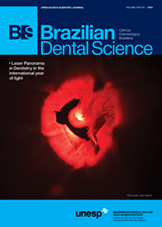Long-term dental follow-up in hematological stem cells transplantation children
DOI:
https://doi.org/10.14295/bds.2015.v18i4.1196Resumo
Objective: The aim of this paper is to update the current published content about the craniofacial long-term development disturbances of childhood hematopoietic stem-cell transplantation (HSCT) and the preparative regimens for the onco-hematological malignancies treatments. Material and Methods: Two authors independently reviewed the published articles about long-term effects of childhood HSCT that fitted in to predetermined inclusion/exclusion criteria: clear definition of exposure or intervention, standard outcomes measurement and appropriate statistical analysis. Results: Twelve papers matched all the previous established eligibility criteria and were included in this review. The children’s age at HSCT were related to a higher risk of dental development disturbances, such as agenesis, dental hypoplasia, root stunting, crown-root proportion alterations, and microdontia. Craniofacial vertical growth was impaired in the irradiated patients without antero-posterior or latero-lateral impairment. Temporomandibular joint dysfunction was found to be more prevalent in the patients who was diagnosed with graft-versus-host disease. Conclusion: The late effects of craniofacial development disturbances leads to several aesthetic and functional impairment, periodontal bone resorption with consequent impairment of chewing ability, and risk of early tooth loss often associated with life’s quality impairment. Further investigations should be performed to provide accurate information for patients, parents and health care professionals.
Keywords: Dental development. Craniofacial growth. Bone marrow transplantation. Hematopoietic stem-cell transplantation. Chemotherapy. Radiotherapy.
Downloads
Downloads
Publicado
Como Citar
Edição
Seção
Licença
TRANSFERÊNCIA DE DIREITOS AUTORAIS E DECLARAÇÃO DE RESPONSABILIDADE
Toda a propriedade de direitos autorais do artigo "____________________________________________________________________" é transferido do autor(es) para a CIÊNCIA ODONTOLÓGICA BRASILEIRA, no caso do trabalho ser publicado. O artigo não foi publicado em outro lugar e não foi submetido simultaneamente para publicação em outra revista.
Vimos por meio deste, atestar que trabalho é original e não apresenta dados manipulados, fraude ou plágio. Fizemos contribuição científica significativa para o estudo e estamos cientes dos dados apresentados e de acordo com a versão final do artigo. Assumimos total responsabilidade pelos aspectos éticos do estudo.
Este texto deve ser impresso e assinado por todos os autores. A versão digitalizada deverá ser apresentada como arquivo suplementar durante o processo de submissão.




























